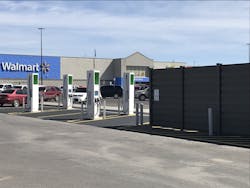Walmart adding nationwide EV Fast Charging network at 1,000+ stores by 2030
If you’re looking for more evidence of the emobility revolution in transportation electrification, simply cast a virtual look ahead to the future parking lot at the U.S. No. 1 physical retailer.
Walmart Inc. announced it will build out its own electric vehicle fast-charging network at thousands of Walmart and Sam’s Club locations nationwide over the rest of this decade. The company already has nearly 1,300 EV fast chargers installed at more than 280 stores in the U.S.
“With a store or club located within 10 miles of approximately 90% of Americans, we are uniquely positioned to deliver a convenient charging option that will help make EV ownership possible whether people live in rural, suburban or urban areas,” Vishal Kapadia, senior vice president of Energy Transformation at Walmart Inc., wrote in a blog on the company’s website this week. “Our goal is to meet the needs of customers and members where they live and open the road to those driving across the country. Easy access to on-the-go charging is a game-changer for drivers who have been hesitant to purchase an EV for concerns they won’t be able to find a charger in a clean, bright and safe location when needed.”
The retailing giant, which generated $573 billion in revenues last year, has always been adept at evaluating and capitalizing the trends in its ever-growing customer base. Its offshoots beyond the namesake department stores are Neighborhood Markets, Sam’s Clubs and Supercenters.
Electric vehicle adoption in the U.S. is lagging behind some developed nations, except in California, but EV sales are growing at a faster pace every year. More than 400,000 EVs were reportedly sold in 2022, according to some reports.
Tesla still dominates the relatively small market at more than 60 percent, but Ford, Toyota, GM and others are growing their model lines in anticipation of battery electric dominance in the 2030s.
Walmart has electrified some of its delivery fleet for customers of its premium W+ service. Last year, it ordered about 4,500 edelivery vans from eVan manufacturer Canoo.
“The way vehicle ownership looks is changing fast, and so is our business,” Kapadia wrote in the Walmart blog.
The retailer corporate leadership has publicly vowed to achieve Net Zero emissions by 2040. The company’s Project Gigaton initiative includes some 4,500 suppliers and itself to reduce or avoid one billion metric tons of greenhouse gas emissions by 2030, through electrification, energy efficiency, waste recycling and other measures.
Since the initiative’s launch in 2017, Walmart reported, suppliers have calculated about 574 million metric tons of emissions reduced or avoided in areas such as energy use, waste, packaging, transportation and product use and design.
-- -- --
(Rod Walton, senior editor for EnergyTech, is a 15-year veteran of covering the energy industry both as a newspaper and trade journalist. He can be reached at [email protected]).
Follow us on Twitter @EnergyTechNews_ and @rodwaltonelp and on LinkedIn
About the Author
Rod Walton, EnergyTech Managing Editor
Managing Editor
For EnergyTech editorial inquiries, please contact Managing Editor Rod Walton at [email protected].
Rod Walton has spent 17 years covering the energy industry as a newspaper and trade journalist. He formerly was energy writer and business editor at the Tulsa World. Later, he spent six years covering the electricity power sector for Pennwell and Clarion Events. He joined Endeavor and EnergyTech in November 2021.
Walton earned his Bachelors degree in journalism from the University of Oklahoma. His career stops include the Moore American, Bartlesville Examiner-Enterprise, Wagoner Tribune and Tulsa World.
EnergyTech is focused on the mission critical and large-scale energy users and their sustainability and resiliency goals. These include the commercial and industrial sectors, as well as the military, universities, data centers and microgrids. The C&I sectors together account for close to 30 percent of greenhouse gas emissions in the U.S.
He was named Managing Editor for Microgrid Knowledge and EnergyTech starting July 1, 2023
Many large-scale energy users such as Fortune 500 companies, and mission-critical users such as military bases, universities, healthcare facilities, public safety and data centers, shifting their energy priorities to reach net-zero carbon goals within the coming decades. These include plans for renewable energy power purchase agreements, but also on-site resiliency projects such as microgrids, combined heat and power, rooftop solar, energy storage, digitalization and building efficiency upgrades.

